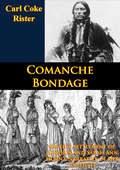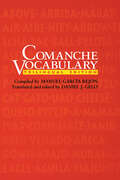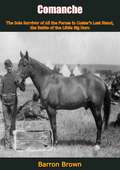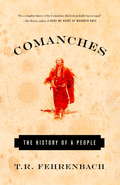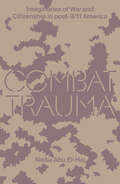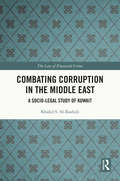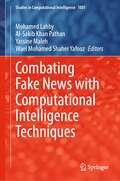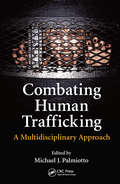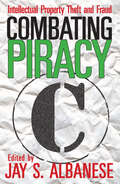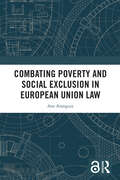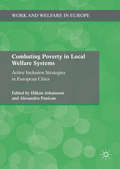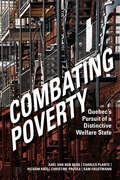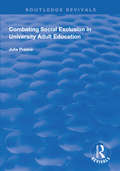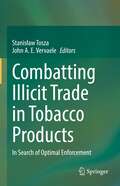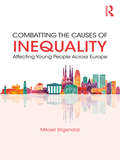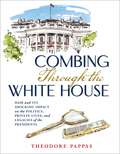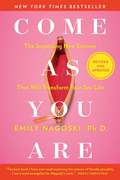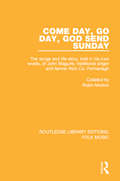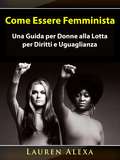- Table View
- List View
Coma and Near-Death Experience: The Beautiful, Disturbing, and Dangerous World of the Unconscious
by Alan Pearce Beverley Pearce• Examines the experiences of those who have survived comas• Demonstrates how a key element of the brain is switched off by coma-inducing sedatives, allowing the mind to break free from the body• Shares proven alternatives to medically-induced coma that are safer for treating critically ill patients and kinder for the patients and their familiesEvery day around the world, thousands of people are placed in medically-induced comas. For some coma survivors, the experience is an utter blank. Others lay paralyzed, aware of everything around them but unable to move, speak, or even blink. Many experience alternate lives spanning decades, lives they grieve once awakened. Some encounter ultra-vivid nightmares, while others undergo a deep, spiritual oneness with the universe or say they have glimpsed the afterlife.Examining the beautiful and disturbing experiences of those who have survived comas, Alan and Beverley Pearce explore the mysterious levels of consciousness this near-death experience unlocks. They demonstrate how a key element of the brain is switched off by coma-inducing sedatives, allowing the mind to break free from the body and experience a greater expansion of consciousness. Revealing the dangers of deep sedation and other intensive care procedures, the authors show how comas are unnecessary more often than not and that many coma survivors go on to suffer lasting cognitive and physical harm. Exploring proven alternatives to medically-induced coma, they share tried and tested protocols that are safer for critically ill patients and kinder for the patients and their families.Showing how we can avoid the suffering caused by comas, this book reveals the wide variety of conscious states that can arise during comas, both positive and negative, and how accepting the reality of these experiences is crucial not only to the recovery of coma survivors but also to the field of consciousness and near-death experience (NDE) studies.
Comanche Bondage: Beales’s Settlement of Dolores and Sarah Ann Horn’s Narrative of Her Captivity
by Carl Coke Rister Sarah Ann HornNo homeseekers were ever plagued with more bad luck than those who followed the Englishman John Charles Beales to southern Texas late in 1834. On the banks of Las Moras Creek, not far from the Rio Grande, they established the colony of Dolores. Among them were the British-born Sarah Ann Horn and her husband and two small sons. For the pretty Sarah Ann, who shared her neighbors’ fear of Comanche raids, the year or so in Dolores was a preview of a special hell to come. The threat of an invasion by Santa Anna, an uncongenial climate, a lack of trees for lumber, an unnavigable river, crop failures, and a scarcity of commodities contributed to the colonists’ discouragement and discord.In Comanche Bondage the distinguished southwestern historian Carl Coke Rister has written the history of the Dolores enterprise, drawing on Beale’s journals and other documents, and including reports of the survivors. Leaving Dolores in the wake of news about the Alamo and Goliad disasters, the Horn family and their neighbors the Harrises headed toward Matamoras. They never arrived there. Later a broken Sarah Ann Horn told the horrifying story of the murder of the men and of the years of captivity she and Mrs. Harris and their children endured at the hands of the Comanches. Rister has edited and annotated her 1839 narrative, which complements and extends his account of Beales’s folly.—Print Ed.
Comanche Vocabulary: Trilingual Edition (Texas Archaeology and Ethnohistory Series)
by Manuel García Rejón&“This is the most important pre-reservation document that we have for the Comanche language . . . It should be in every university research library.&” —James A. Goss, Professor of Anthropology, Texas Tech University The Comanche Vocabulary collected in Mexico during the years 1861–1864 by Manuel García Rejón is by far the most extensive Comanche word list compiled before the establishment of the Kiowa-Comanche-Apache Reservation in 1867. It preserves words and concepts that have since changed or even disappeared from the language, thus offering a unique historical window on earlier Comanche culture. This translation adds the English equivalents to the original Spanish-Comanche list of 857 words, as well as a Comanche-English vocabulary and comparisons with later Comanche word lists. Daniel J. Gelo&’s introduction discusses the circumstances in which García Rejón gathered his material and annotates significant aspects of the vocabulary in light of current knowledge of Comanche language and culture. The book also includes information on pictography, preserving a rare sample of Comanche scapula drawing. This information will help scholars understand the processes of language evolution and cultural change that occurred among all Native American peoples following European contact. The Comanche Vocabulary will also hold great interest for the large public fascinated by this once-dominant tribe.
Comanche: The Sole Survivor of All the Forces in Custer’s Last Stand, the Battle of the Little Big Horn
by Barron BrownComanche, first published in 1935 and beautifully illustrated by the book’s author Barron Brown, is an account of the U.S. Army horse “Comanche,” who survived General George Armstrong Custer’s detachment of the United States 7th Cavalry at the Battle of the Little Bighorn in 1876.“Comanche” was bought by the U.S. Army in 1868 in St. Louis, Missouri and sent to Fort Leavenworth, Kansas. He was captured in a wild horse roundup on April 3, 1868. Captain Myles Keogh of the 7th Cavalry liked the 15 hands (60 inches, 152 cm) gelding and bought him for his personal mount, to be ridden only in battle.In 1868, while the army was fighting the Comanche in Kansas, the horse was wounded in the hindquarters by an arrow but continued to carry Keogh in the fight. He named the horse “Comanche” to honor his bravery. “Comanche” was wounded many more times but always exhibited the same toughness.It was on June 25, 1876 that Captain Keogh rode “Comanche” at the Battle of the Little Bighorn, led by Lt. Col. George Armstrong Custer, in which their entire detachment was killed. U.S. soldiers found “Comanche,” badly wounded, two days after the battle. After being transported to Fort Lincoln, he was slowly nursed back to health. After a lengthy convalescence, “Comanche” was retired.In June 1879, “Comanche” was brought to Fort Meade by the Seventh Regiment, where he was kept like a prince until 1887. He was taken to Fort Riley, Kansas. As an honor, he was made “Second Commanding Officer” of the 7th Cavalry.“Comanche” died of colic on November 7, 1891, believed to be 29 years old at the time. He is one of only three horses in U.S. history to be given a military funeral with full military honors, the others were “Black Jack” and “Sergeant Reckless.” His remains were sent to the University of Kansas and preserved, where the taxidermy mount can still be seen today in the university’s Natural History Museum.
Comanches: The History of a People
by T. R. FehrenbachAuthoritative and immediate, this is the classic account of the most powerful of the American Indian tribes. T. R. Fehrenbach traces the Comanches' rise to power, from their prehistoric origins to their domination of the high plains for more than a century until their demise in the face of Anglo-American expansion. Master horseback riders who lived in teepees and hunted bison, the Comanches were stunning orators, disciplined warriors, and the finest makers of arrows. They lived by a strict legal code and worshipped within a cosmology of magic. As he portrays the Comanche lifestyle, Fehrenbach re-creates their doomed battle against European encroachment. While they destroyed the Spanish dream of colonizing North America and blocked the French advance into the Southwest, the Comanches ultimately fell before the Texas Rangers and the U.S. Army in the great raids and battles of the mid-nineteenth century. This is a classic American story, vividly and poignantly told.
Combat Trauma: Imaginaries of War and Citizenship in post-9/11 America
by Nadia Abu El-HajAmericans have long been asked to support the troops and care for veterans&’ psychological wounds. Who, though, does this injunction serve? As acclaimed scholar Nadia Abu El-Haj argues here, in the American public&’s imagination, the traumatized soldier stands in for destructive wars abroad, with decisive ramifications in the post-9/11 era. Across the political spectrum the language of soldier trauma is used to discuss American warfare, producing a narrative in which traumatized soldiers are the only acknowledged casualties of war, while those killed by American firepower are largely sidelined and forgotten. In this wide-ranging and fascinating study of the meshing of medicine, science, and politics, Abu El-Haj explores the concept of post-traumatic stress disorder and the history of its medical diagnosis. While antiwar Vietnam War veterans sought to address their psychological pain even as they maintained full awareness of their guilt and responsibility for perpetrating atrocities on the killing fields of Vietnam, by the 1980s, a peculiar convergence of feminist activism against sexual violence and Reagan&’s right-wing &“war on crime&” transformed the idea of PTSD into a condition of victimhood. In so doing, the meaning of Vietnam veterans&’ trauma would also shift, moving away from a political space of reckoning with guilt and complicity to one that cast them as blameless victims of a hostile public upon their return home. This is how, in the post-9/11 era of the Wars on Terror, the injunction to &“support our troops,&” came to both sustain US militarism and also shields American civilians from the reality of wars fought ostensibly in their name. In this compelling and crucial account, Nadia Abu El-Haj challenges us to think anew about the devastations of the post-9/11 era.
Combating Corruption in the Middle East: A Socio-Legal Study of Kuwait (The Law of Financial Crime)
by Khaled S. Al-RashidiThis book examines the phenomenon of ‘grand corruption’ in Kuwait and the pattern in the wider region. Taking an interdisciplinary approach, the work places corruption in its sociological, political and economic context to explore the relationship between the characteristics of Kuwait as a state with an endemic corruption problem. It then focuses on laws and regulations as key problem-solving mechanisms. In doing so, it identifies, explores, and assesses the existing counter-corruption laws and regulations in Kuwait in a broad socio-political-economic context. The work goes beyond doctrinal legal research, employing empirical methodology based on semi-structured interviews with elite politicians and professional experts from criminal justice and non-governmental organisations (NGOs). These valuable and original insights are reflected upon throughout the study. The grand corruption that permeates the tier of high-profile officials in Kuwait is replicated in many developing countries where accountability mechanisms regularly suffer from lack of enforcement. The appeal of this book is its application to numerous jurisdictions, and the Gulf Cooperation Council (GCC) countries and Middle East in particular. It will be a valuable resource for academics, researchers, and policymakers working in the areas of financial crime and corruption.
Combating Fake News with Computational Intelligence Techniques (Studies in Computational Intelligence #1001)
by Al-Sakib Khan Pathan Yassine Maleh Mohamed Lahby Wael Mohamed Shaher YafoozThis book presents the latest cutting-edge research, theoretical methods, and novel applications in the field of computational intelligence techniques and methods for combating fake news. Fake news is everywhere. Despite the efforts of major social network players such as Facebook and Twitter to fight disinformation, miracle cures and conspiracy theories continue to rain down on the net. Artificial intelligence can be a bulwark against the diversity of fake news on the Internet and social networks. This book discusses new models, practical solutions, and technological advances related to detecting and analyzing fake news based on computational intelligence models and techniques, to help decision-makers, managers, professionals, and researchers design new paradigms considering the unique opportunities associated with computational intelligence techniques. Further, the book helps readers understand computational intelligence techniques combating fake news in a systematic and straightforward way.
Combating Human Trafficking: A Multidisciplinary Approach
by Michael J. PalmiottoApproaching the topic from a law enforcement perspective, this volume provides an unprecedented look at the investigation of human trafficking in America. Beginning with historical, sociological, and psychological perspectives, the book discusses how authorities can best conduct an investigation of trafficking. It reviews federal agencies responsible for confronting the problem, examines relevant laws and legal trends, and discusses law enforcement awareness and training. An ideal resource for police investigators, police training, and community outreach organizations, the book is also suitable as a college text for criminal justice courses.
Combating Piracy: Intellectual Property Theft and Fraud
by AuthorFraud and piracy of products and ideas have become common in the early twenty-first century, as opportunities to commit them expand, and technology makes fraud and piracy easy to carry out. In Combating Piracy: Intellectual Property Theft and Fraud, Jay S. Albanese and his contributors provide new analyses of intellectual property theft and how perpetrators innovate and adapt in response to shifting opportunities.The cases described here illustrate the wide-ranging nature of the activity and the spectrum of persons involved in piracy of intellectual property. Intellectual property theft includes stolen copyrights, trademarks, trade secrets, and patents, which represent the creative work of individuals for which others cannot claim credit. The distributors of books, movies, music, and other forms of intellectual property pay for this right, and those who distribute this work without compensation to its creator effectively hijack or "pirate" that property without the owner's or distributor's permission. The problem has grown to the point where most software in many parts of the world is pirated. The World Health Organization estimates that 10 percent of all pharmaceuticals available worldwide are counterfeit.Such widespread fraud illustrates the global reach of the problem and the need for international remedies that include changed attitudes, public education, increasing the likelihood of apprehension, and reducing available opportunities. The contributors show that piracy is a form of fraud, a form of organized crime, a white-collar crime, a criminal activity with causes we can isolate and prevent, and a global problem. This book examines each of these perspectives to determine how they contribute to our understanding of the issues involved.
Combating Poverty and Social Exclusion in European Union Law
by Ane AranguizThis book examines the potential role of European Union law in combating poverty and social exclusion in the European Union. Anti-poverty strategies have been part of the European Union agenda for decades. Most saliently, over a decade ago, the EU’s Member States pledged to lift 20 million people out of poverty. In spite of this commitment, the EU did not even meet a quarter of this target, and over 113 million people still were at risk of poverty and social exclusion by the end of 2020. This book addresses the incongruence between a quite developed EU policy strategy and a well-embedded legal objective on the one hand, and the lack of direct legal action on the other. Analysing the role of social policy instruments, fundamental rights, and the constitutional framework of the European Union, it makes a detailed case for a contribution of EU law to the policy objective of combating poverty and social exclusion. Drawing on work in law, politics, social policy and economics, this book will interest scholars and policymakers in the areas of EU law, labour and social security, human rights, political science and social and public policy.
Combating Poverty and Social Exclusion in European Union Law
by Ane AranguizThis book examines the potential role of European Union law in combating poverty and social exclusion in the European Union.Anti-poverty strategies have been part of the European Union agenda for decades. Most saliently, over a decade ago, the EU’s Member States pledged to lift 20 million people out of poverty. In spite of this commitment, the EU did not even meet a quarter of this target, and over 113 million people still were at risk of poverty and social exclusion by the end of 2020. This book addresses the incongruence between a quite developed EU policy strategy and a well-embedded legal objective on the one hand, and the lack of direct legal action on the other. Analysing the role of social policy instruments, fundamental rights, and the constitutional framework of the European Union, it makes a detailed case for a contribution of EU law to the policy objective of combating poverty and social exclusion.Drawing on work in law, politics, social policy and economics, this book will interest scholars and policymakers in the areas of EU law, labour and social security, human rights, political science and social and public policy.The Open Access version of this book, available at www.taylorfrancis.com, has been made available under a Creative Commons Attribution (CC-BY) 4.0 license.
Combating Poverty in Local Welfare Systems (Work and Welfare in Europe)
by Håkan Johansson Alexandru PanicanThis book analyzes national anti-poverty measures at a local level via a set of unique and up-to-date empirical studies of minimum income support schemes and activation measures in five European cities. In examining this 'local welfare system' approach, it investigates the role that civil society organizations play, and the governance arrangements that prevail in contacts between public and civil society actors in local anti-poverty strategies. The current financial and economic crisis has caused increasing levels of poverty and unemployment, and put national minimum income protection schemes under severe strain. Combating Poverty in Local Welfare Systems therefore represents a timely and important intervention in the political and scientific debates as to whether more 'local welfare' is the solution to the challenges facing European welfare states.
Combating Poverty: Quebec's Pursuit of a Distinctive Welfare State
by Axel van den Berg Charles Plante Hicham Raiq Christine Proulx Sam FaustmannCombating Poverty critically analyses the growing divergence between Quebec and other large Canadian provinces in terms of social and labour market policies and their outcomes over the past several decades. While Canada is routinely classified as a single, homogeneous ‘liberal market’ regime, social and labour market policy falls within provincial jurisdiction resulting in a considerable divergence in policy mixes and outcomes between provinces. This volume offers a detailed survey of social and labour market policies since the early 2000s in Canada’s four largest provinces – Ontario, Quebec, British Columbia, and Alberta – showing the full extent to which Canada’s major provinces have chosen diverging policy paths. Quebec has succeeded in emulating European and even Nordic social democratic levels of poverty for some groups, while poverty rates and patterns in the other provinces remain close to the high levels characteristic of the North American liberal, market-oriented regime. Combating Poverty provides a unique and timely reflection on the political implications and sustainability of Canada’s fragmented welfare state.
Combating Social Exclusion in University Adult Education (Routledge Revivals)
by Julia PreecePublished in 1999, this work suggests that widening participation is not just about changing learner expectations; it is also about changing institutional expectations and practices. "Higher" learning, for example, should include a broader, more inclusive range of knowledge and ways of knowing than at present and criteria for learning achievement should include assessment of "citizenship" as well as linear outcomes.
Combating Violence and Abuse of People with Disabilities: A Call to Action
by Nancy M. FitzsimonsThis book is written for and is about people with all types of disabilities-- physical, sensory (vision or hearing), intellectual, and mental health. The focus is on adults with disabilities, not children. Although much of the information applies to children with disabilities, this book is written using the research and literature about adults with disabilities. The resources provided are adult focused. The ideas for combating violence and abuse are geared toward adults. This book addresses abuse of both men and women with disabilities. However, it is important to know that the majority of research and writing on this issue is about women with disabilities. So far, very little emphasis has been placed on understanding abuse of men with disabilities. This book is also written for all of the people who support or provide services to people with disabilities. When victims need supports and services to increase their independence, disability services professionals play an important part. In short, many professionals, along with family members and friends, need to take action.
Combatting Illicit Trade in Tobacco Products: In Search of Optimal Enforcement
by Stanisław Tosza John A. E. VervaeleThis book focuses on the enforcement aspect of tobacco control policy, and argues that the intense regulation of the tobacco market will never be successful as long as it can be circumvented by the availability of illicit tobacco products. Yet, current efforts to combat illicit tobacco trade are insufficient, suffering from several flaws and gaps at the regulatory and operational levels. The aim of this book is to provide an analysis of the legal framework and practice of enforcement with regard to illicit tobacco products. Combining criminological and legal perspectives, it presents and critically analyses the phenomenon of illicit tobacco trade, as well as the policies, legal frameworks and practices in six EU countries with regard to combatting this phenomenon, assessing the strengths and weaknesses of their approaches. Furthermore, it studies the relationship between the EU and third countries (e.g. Ukraine) in terms of how the EU can influence policy and enforcement in these countries in order to counter illicit tobacco trafficking. Not exclusively focusing on the EU, the book also includes an analysis of enforcement against illicit tobacco products in the US. The EU Member States analysed in the book (Belgium, Germany, Italy, Latvia, the Netherlands and Poland) reflect the range of currently available approaches. Some of them have ratified the WHO Protocol against tobacco smuggling; others have not. They belong to different legal traditions and face different challenges due to their respective border situations. While Belgium and the Netherlands are key entry ports to the EU, Poland and Latvia represent the Eastern land border of the EU, with various regional challenges. Italy has a long maritime border, where trafficking is possible from Northern Africa and from the Middle East. It also has significant experience in fighting organised crime. Lastly, Germany is the largest market in Europe and situated in the middle of these trafficking routes.
Combatting the Causes of Inequality Affecting Young People Across Europe
by Mikael StigendalInequality is one of the most burning issues of our time, affecting young people in particular. What causes inequality? And how can actors at the local level combat the causes, not only the symptoms? By seeking to answer these questions, the book will contribute to this growing and transdisciplinary subject area by using mainly qualitative research and a perspective that integrates theory in every phase of the analysis. Drawing on cultural political economy, based on critical realism, the author claims that the most important causes of inequality are the ones inherent as potentials in capitalism and the capitalist type of state. Compared with the first post-war decades, these potential causes have been actualised differently since around 1980. They are also actualised differently across Europe. The book explores these differences concerning growth models and welfare regimes. In general, societies have developed into a new condition of social inclusion, which explains why many young people have become excluded. Societal borders have arisen in the cities, separating the winners and losers of inequality. Positioning itself outside the box of what tends to be the majority of the publications in the field, the book proposes knowledge alliances between young people, policy-makers, civil society and researchers to combat the causes of inequality.
Combing Through the White House: Hair and Its Shocking Impact on the Politics, Private Lives, and Legacies of the Presidents
by Theodore PappasDiscover a fascinating and novel look at the U.S. presidents, the first families, and American history—all through the lens of hair. With meticulous detail, engaging storytelling, and full-color visuals, encyclopedia editor Theodore Pappas combs through American history, teasing out long-forgotten and little-known ways that hair has influenced the presidency and the public and private lives, personal scandals, and tragedies of the men and women who have occupied the White House.Go deep into the history of such topics as:Abraham Lincoln's famously ridiculed appearance and the surprising role hair played in both his presidency and assassinationJohn F. Kennedy's connection to James Bond and how hair factored into his vast image-making and infidelitiesThe lush tradition of collecting hair as a way of honoring leaders, remembering our loved ones, and preserving their memoriesScientific hair analysis and how DNA has been used to solve long-standing presidential mysteriesThe connection of hair to the lives, loves, scandals, and tragedies that shaped presidents, first ladies, and the nation at large This unique window into the past shines entertaining new light on the decisions, relationships, and tragedies that have shaped the role of the president and the place of the U.S. in the world. Whether you're interested in presidential trivia or historical mysteries, Combing Through the White House personalizes the past through an element of life we can all relate to—hair—giving us new glimpses into our country and even ourselves.
Come As You Are: The Surprising New Science That Will Transform Your Sex Life
by Emily NagoskiA revised and updated edition of Emily Nagoski&’s game-changing New York Times bestseller Come As You Are, featuring new information and research on mindfulness, desire, and pleasure that will radically transform your sex life.For much of the 20th and 21st centuries, women&’s sexuality was an uncharted territory in science, studied far less frequently—and far less seriously—than its male counterpart. That is, until Emily Nagoski&’s Come As You Are, which used groundbreaking science and research to prove that the most important factor in creating and sustaining a sex life filled with confidence and joy is not what the parts are or how they&’re organized but how you feel about them. In the years since the book&’s initial publication, countless women have learned through Nagoski&’s accessible and informative guide that things like stress, mood, trust, and body image are not peripheral factors in a woman&’s sexual wellbeing; they are central to it—and that even if you don&’t always feel like it, you are already sexually whole by just being yourself. This revised and updated edition continues that mission with new information and advanced research, demystifying and decoding the science of sex so that everyone can create a better sex life and discover more pleasure than you ever thought possible.
Come Back to Me (A Seal Island novel): A gripping love story from the author of THE ITALIAN VILLA
by Daniela SacerdotiFrom the bestselling author of The Italian Villa and Watch Over Me, a romantic, moving and uplifting story of three different lives, connected by a thread. Perfect for anyone who loves Fiona Valpy and Lily Graham.'Atmospheric, romantic and compelling. Daniela writes with huge warmth and sincerity' Rosanna LeyThree separate lives. Three broken hearts.Haunted by his wife's death, Matt arrives on Seal Island determined to be alone and unable to escape his grief. In the island's hospital, a young woman named Rose lies in a coma, trapped by the memories of events leading up to her accident. Grace, the island's doctor, is at the heart of the community. Only she knows how much she regrets turning down the chance of love and a family years ago.For these three people hope seems gone. But life is about to offer an unexpected new beginning...Readers adore the captivating novels of Daniela Sacerdoti'A love story that will satisfy even the most hopeless romantics' Daily Express'Beautifully written and atmospheric' The Sun 'A great book' Lesley Pearse'Emotional. I couldn't put it down' Daily Mail'I fell in love with this book' Prima magazine
Come Back to Me (A Seal Island novel): A gripping love story from the author of THE ITALIAN VILLA
by Daniela SacerdotiFrom the bestselling author of WATCH OVER ME, Daniela Sacerdoti's latest Seal Island novel is a romantic, moving and uplifting story of three different lives, connected by a thread.** Over 1 million copies sold of Daniela Sacerdoti's novels **When all seems lost...Matt - grief-stricken after his beloved wife's death, he arrives on Seal Island desperate to hide from the world.Grace - the island's doctor believes she's left it too late to find love or have a family.Rose - lying in a coma at a hospital on Seal, a young woman fights for her life, recalling the journey that led to her accident. ...life can surprise you with a new beginning.(P)2019 Headline Publishing Group Ltd
Come Day, Go Day, God Send Sunday: The songs and life story, told in his own words, of John Maguire, traditional singer and farmer from Co. Fermanagh. (Routledge Library Editions: Folk Music #6)
by Robin MortonOriginally published in 1973. Folk-life and folk-culture, usually the preserve of the scholar, have been brought vividly and entertainingly to life in these recollections and stories of one man’s life in the Irish countryside. This book tells the life story of John Maguire, who died in 1975, including over 50 of the songs he sang, with full musical transcriptions. He was a fine singer, firmly within the Irish tradition, and his songs are the record of a people, their history and traditions, their joys and sufferings, their comedies and tragedies. John Maguire’s fascinating story, skilfully and unobtrusively collated by Robin Morton, is full of material that will interest singers and students of folksongs. His songs and music will be of value to all those interested in traditional music and song.
Come Essere Femminista: Una Guida per Donne alla Lotta per Diritti e Uguaglianza
by Lauren AlexaSei mai stata vittima di violenza, odio, molestie e sofferenza dovuti al tuo sesso di appartenenza? Essere femminista e praticare gli ideali femministi significa combattere per cose importanti. Parità di salario, essere trattate con rispetto, tutela del congedo di maternità, diritti riproduttivi, violenza domestica e molto altro. Se desideri saperne di più sulla lotta per i tuoi diritti e per aiutare le donne di tutto il mondo a combattere per i propri, allora questa guida fa al caso tuo. - Impara a essere femminista. - Impara a combattere per i tuoi diritti. - Lotta per l’uguaglianza e per la parità di salario. - E Molto Altro! Scopri come fare per stare dalla parte giusta della nostra storia, aiutando l’umanità dov’è più necessario! --> Scorri verso la parte alta della pagina e clicca su “aggiungi al carrello” per effettuare immediatamente l’acquisto Disclaimer: L’autrice e/o i titolari dei diritti non avanzano pretese, promesse o garanzie relativamente all’accuratezza, alla completezza o all’adeguatezza dei contenuti di questo libro, e declinano espressamente qualsiasi responsabilità legata a eventuali errori od omissioni presenti. Il prodotto va inteso solo come riferimento. Si prega di consultare un/una professionista prima di agire sulla base dei contenuti ivi compresi.
Come Essere una Basic Bitch
by Hiddenstuff EntertainmentSei una basic bitch? Ami il vino, gli amici, i brunch, le città, la moda, fare shopping e qualsiasi cosa di consumistico? Non vergognartene, lo stile di vita da basic bitch è uno dei più sfarzosi e gradevoli che potresti vivere. Perché non viziarti e vivere bene, star meglio di chiunque altro, e cosa ancora più importante essere felice ed in salute? Se questo è lo stile di vita che stai conducendo o vorresti condurre, allora questo manuale è per te. Impara le cose da fare e non fare per essere una basic bitch e come esserlo meglio di chiunque altro. --> Vai in cima alla pagina e clicca su aggiungi al carrello per acquistarlo immediatamente Disclaimer: This author and or rights owner(s) make no claims, promises, or guarantees in regards to the accuracy, completeness, or adequacy of the contents of this book, and expressly disclaims liability for errors and omissions in the contents within. This product is for reference use only. Please consult a professional before taking action on any of the contents found within.

